Microscope-Based Augmented Reality with Intraoperative Computed Tomography-Based Navigation for Resection of Skull Base Meningiomas in Consecutive Series of 39 Patients
Abstract
:Simple Summary
Abstract
1. Introduction
2. Materials and Methods
2.1. General Setup
2.2. Augmented Reality
3. Results
Illustrative Cases
4. Discussion
5. Conclusions
Supplementary Materials
Author Contributions
Funding
Institutional Review Board Statement
Informed Consent Statement
Data Availability Statement
Acknowledgments
Conflicts of Interest
References
- Dolati, P.; Gokoglu, A.; Eichberg, D.; Zamani, A.; Golby, A.; Al-Mefty, O. Multimodal navigated skull base tumor resection using image-based vascular and cranial nerve segmentation: A prospective pilot study. Surg. Neurol. Int. 2015, 6, 172. [Google Scholar] [CrossRef] [PubMed] [Green Version]
- Rachinger, J.; Von Keller, B.; Ganslandt, O.; Fahlbusch, R.; Nimsky, C. Application Accuracy of Automatic Registration in Frameless Stereotaxy. Stereotact. Funct. Neurosurg. 2006, 84, 109–117. [Google Scholar] [CrossRef] [PubMed] [Green Version]
- Eggers, G.; Kress, B.; Mühling, J. Fully Automated Registration of Intraoperative Computed Tomography Image Data for Image-Guided Craniofacial Surgery. J. Oral Maxillofac. Surg. 2008, 66, 1754–1760. [Google Scholar] [CrossRef]
- Carl, B.; Bopp, M.; Saß, B.; Nimsky, C. Intraoperative computed tomography as reliable navigation registration device in 200 cranial procedures. Acta Neurochir. 2018, 160, 1681–1689. [Google Scholar] [CrossRef] [PubMed]
- Carl, B.; Bopp, M.; Saß, B.; Pojskic, M.; Nimsky, C. Augmented reality in intradural spinal tumor surgery. Acta Neurochir. 2019, 161, 2181–2193. [Google Scholar] [CrossRef]
- Cabrilo, I.; Sarrafzadeh, A.; Bijlenga, P.; Landis, B.; Schaller, K. Augmented reality-assisted skull base surgery. Neurochirurgie 2014, 60, 304–306. [Google Scholar] [CrossRef]
- Carl, B.; Bopp, M.; Voellger, B.; Saß, B.; Nimsky, C. Augmented Reality in Transsphenoidal Surgery. World Neurosurg. 2019, 125, e873–e883. [Google Scholar] [CrossRef]
- Lai, M.; Skyrman, S.; Shan, C.; Babic, D.; Homan, R.; Edström, E.; Persson, O.; Burström, G.; Elmi-Terander, A.; Hendriks, B.H.; et al. Fusion of augmented reality imaging with the endoscopic view for endonasal skull base surgery; a novel application for surgical navigation based on intraoperative cone beam computed tomography and optical tracking. PLoS ONE 2020, 15, e0227312. [Google Scholar]
- Pennacchietti, V.; Stoelzel, K.; Tietze, A.; Lankes, E.; Schaumann, A.; Uecker, F.C.; Thomale, U.W. First experience with augmented reality neuronavigation in endoscopic assisted midline skull base pathologies in children. Child’s Nerv. Syst. 2021, 37, 1525–1534. [Google Scholar] [CrossRef]
- Creighton, F.X.; Unberath, M.; Song, T.; Zhao, Z.; Armand, M.; Carey, J. Early Feasibility Studies of Augmented Reality Navigation for Lateral Skull Base Surgery. Otol. Neurotol. 2020, 41, 883–888. [Google Scholar] [CrossRef]
- Roethe, A.L.; Rösler, J.; Misch, M.; Vajkoczy, P.; Picht, T. Augmented reality visualization in brain lesions: A prospective randomized controlled evaluation of its potential and current limitations in navigated microneurosurgery. Acta Neurochir. 2021, 164, 3–14. [Google Scholar] [CrossRef] [PubMed]
- Lavé, A.; Meling, T.R.; Schaller, K.; Corniola, M.V. Augmented reality in intracranial meningioma surgery: Report of a case and systematic review. J. Neurosurg. Sci. 2020, 64, 369–376. [Google Scholar] [CrossRef] [PubMed]
- Jean, W.C. Mini-Pterional Craniotomy and Extradural Clinoidectomy for Clinoid Meningioma: Optimization of Exposure Using Augmented Reality Template: 2-Dimensional Operative Video. Oper. Neurosurg. 2020, 19, E610. [Google Scholar] [CrossRef] [PubMed]
- McDermott, M.W.; Ohata, K.; Benes, V. Introduction. Skull base meningioma treatment strategies. Neurosurg. Focus 2018, 44, E1. [Google Scholar] [CrossRef] [PubMed]
- Magill, S.T.; Ore, C.L.D.; Diaz, M.A.; Jalili, D.D.; Raleigh, D.R.; Aghi, M.K.; Theodosopoulos, P.V.; McDermott, M.W. Surgical outcomes after reoperation for recurrent non–skull base meningiomas. J. Neurosurg. 2018, 131, 1179–1187. [Google Scholar] [CrossRef] [Green Version]
- Meling, T.R.; Da Broi, M.; Scheie, D.; Helseth, E. Meningiomas: Skull base versus non-skull base. Neurosurg. Rev. 2018, 42, 163–173. [Google Scholar] [CrossRef]
- DeMonte, F.; McDermott, M.W.; Al-Mefty, O. Al-Mefty’s Meningiomas; Thieme Medical Publishers Inc.: New York, NY, USA, 2011. [Google Scholar]
- Simpson, D. The Recurrence of intracranial meningiomas after surgical treatment. J. Neurol. Neurosurg. Psychiatry 1957, 20, 22–39. [Google Scholar] [CrossRef] [Green Version]
- Combs, S.E.; Edler, L.; Burkholder, I.; Rieken, S.; Habermehl, D.; Jäkel, O.; Haberer, T.; Unterberg, A.; Wick, W.; Debus, J.; et al. Treatment of patients with atypical meningiomas Simpson grade 4 and 5 with a carbon ion boost in combination with postoperative photon radiotherapy: The MARCIE Trial. BMC Cancer 2010, 10, 615. [Google Scholar] [CrossRef] [Green Version]
- Savardekar, A.R.; Patra, D.P.; Bir, S.; Thakur, J.D.; Mohammed, N.; Bollam, P.; Georgescu, M.-M.; Nanda, A. Differential Tumor Progression Patterns in Skull Base Versus Non–Skull Base Meningiomas: A Critical Analysis from a Long-Term Follow-Up Study and Review of Literature. World Neurosurg. 2018, 112, e74–e83. [Google Scholar] [CrossRef]
- Di Maio, S.; Ramanathan, D.; Garcia-Lopez, R.; Rocha, M.H.; Guerrero, F.P.; Ferreira, M., Jr.; Sekhar, L.N. Evolution and future of skull base surgery: The paradigm of skull base meningiomas. World Neurosurg. 2012, 78, 260–275. [Google Scholar] [CrossRef]
- Cho, J.; Rahimpour, S.; Cutler, A.; Goodwin, C.R.; Lad, S.P.; Codd, P. Enhancing Reality: A Systematic Review of Augmented Reality in Neuronavigation and Education. World Neurosurg. 2020, 139, 186–195. [Google Scholar] [CrossRef] [PubMed]
- Schichor, C.; Terpolilli, N.; Thorsteinsdottir, J.; Tonn, J.-C. Intraoperative Computed Tomography in Cranial Neurosurgery. Neurosurg. Clin. N. Am. 2017, 28, 595–602. [Google Scholar] [CrossRef] [PubMed]
- Terpolilli, N.A.; Rachinger, W.; Kunz, M.; Thon, N.; Flatz, W.H.; Tonn, J.-C.; Schichor, C. Orbit-associated tumors: Navigation and control of resection using intraoperative computed tomography. J. Neurosurg. 2016, 124, 1319–1327. [Google Scholar] [CrossRef] [PubMed] [Green Version]
- Wirtz, C.R. Intraoperative navigation, with focus on the skull base. HNO 2016, 64, 635–640. [Google Scholar] [CrossRef]
- Marcus, H.; Schwindack, C.; Santarius, T.; Mannion, R.; Kirollos, R. Image-guided resection of spheno-orbital skull-base meningiomas with predominant intraosseous component. Acta Neurochir. 2013, 155, 981–988. [Google Scholar] [CrossRef]
- Carl, B.; Bopp, M.; Saß, B.; Pojskic, M.; Gjorgjevski, M.; Voellger, B.; Nimsky, C. Reliable navigation registration in cranial and spine surgery based on intraoperative computed tomography. Neurosurg. Focus 2019, 47, E11. [Google Scholar] [CrossRef] [Green Version]
- Watanabe, K.; Zomorodi, A.R.; Labidi, M.; Satoh, S.; Froelich, S.; Fukushima, T. Visualization of Dark Side of Skull Base with Surgical Navigation and Endoscopic Assistance: Extended Petrous Rhomboid and Rhomboid with Maxillary Nerve–Mandibular Nerve Vidian Corridor. World Neurosurg. 2019, 129, e134–e145. [Google Scholar] [CrossRef]
- Bir, S.C.; Konar, S.K.; Maiti, T.K.; Thakur, J.D.; Guthikonda, B.; Nanda, A. Utility of Neuronavigation in Intracranial Meningioma Resection: A Single-Center Retrospective Study. World Neurosurg. 2016, 90, 546–555.e1. [Google Scholar] [CrossRef]
- Narayan, V.; Bir, S.C.; Mohammed, N.; Savardekar, A.R.; Patra, D.P.; Nanda, A. Surgical Management of Giant Intracranial Meningioma: Operative Nuances, Challenges, and Outcome. World Neurosurg. 2018, 110, e32–e41. [Google Scholar] [CrossRef]

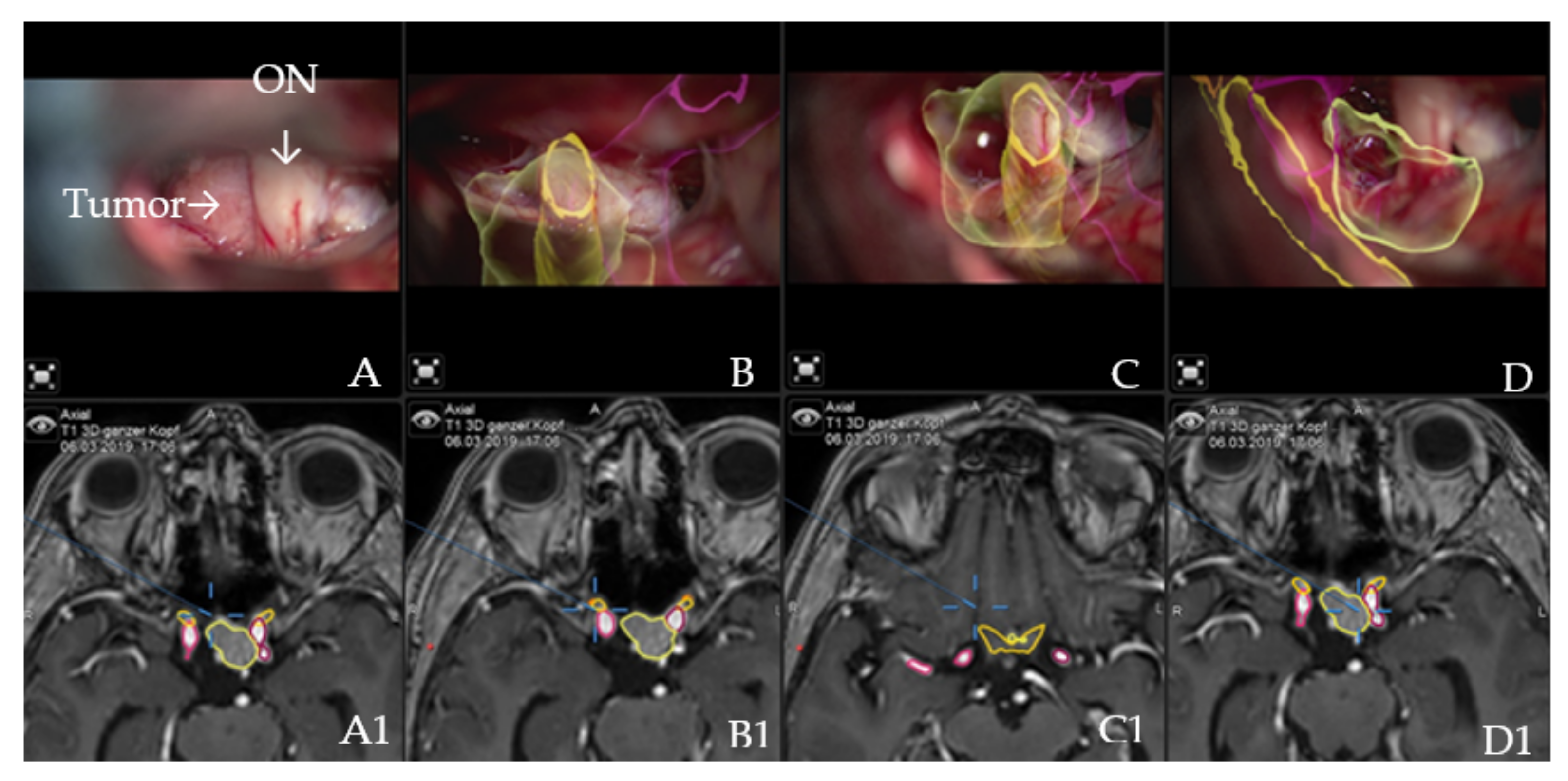
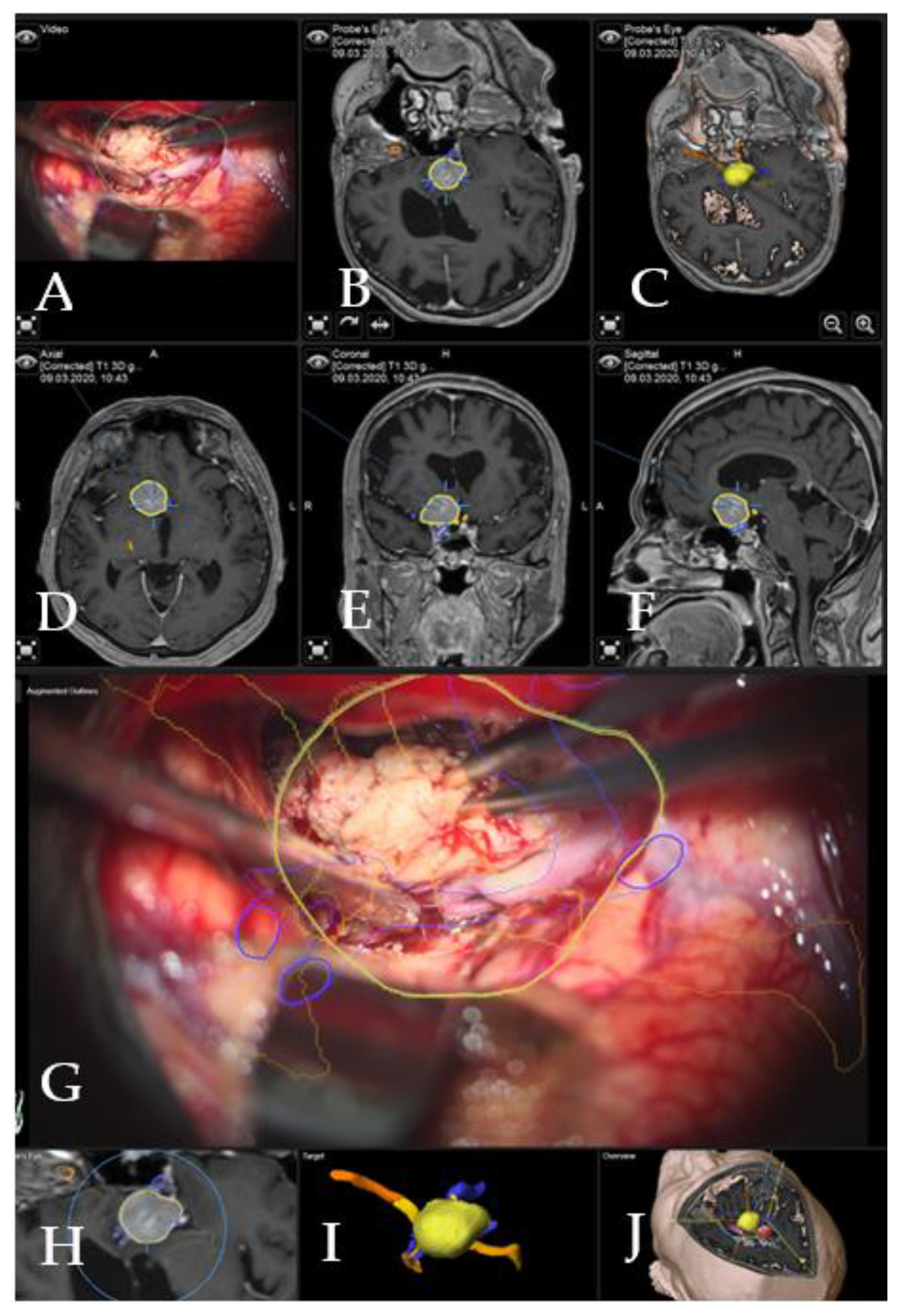
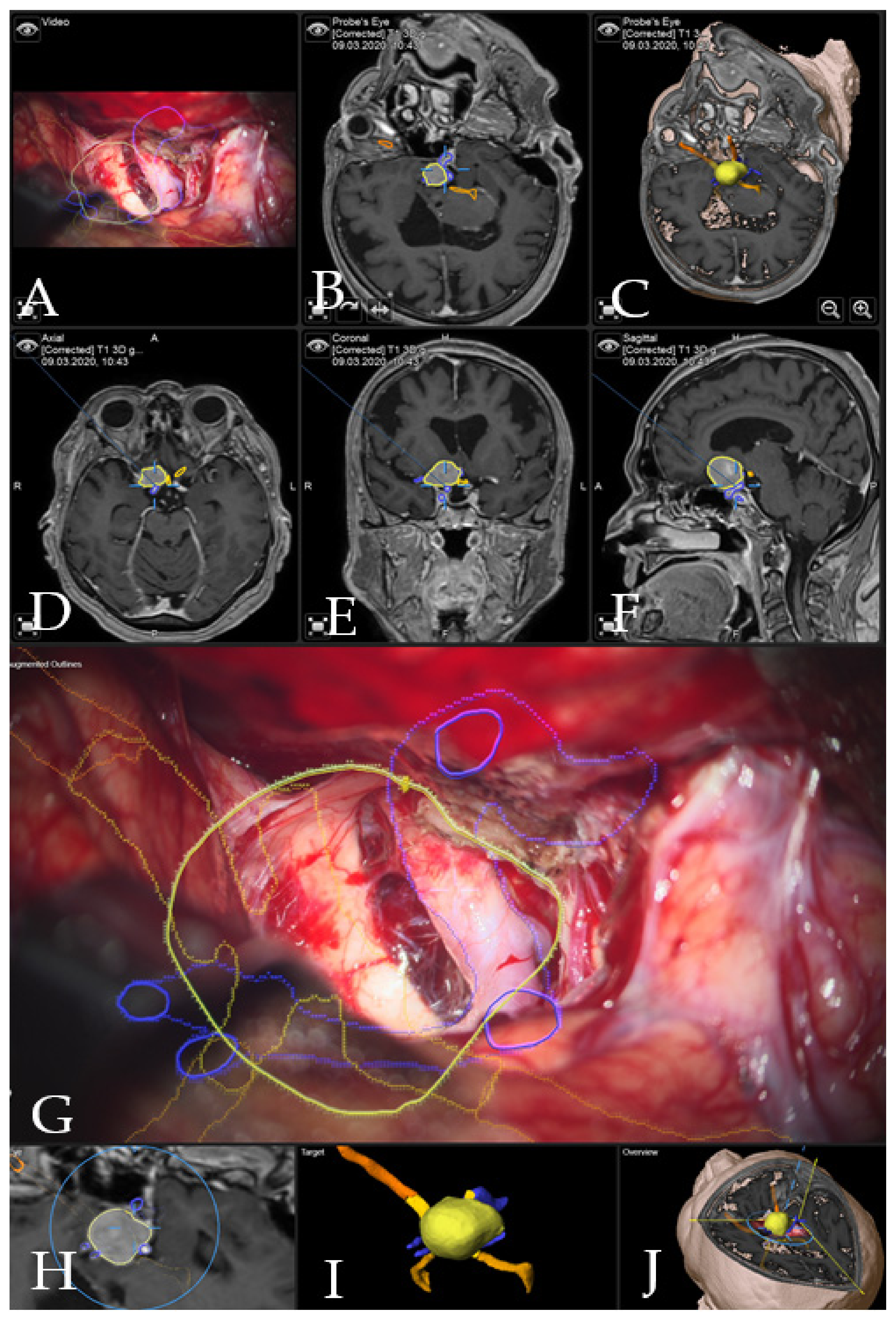
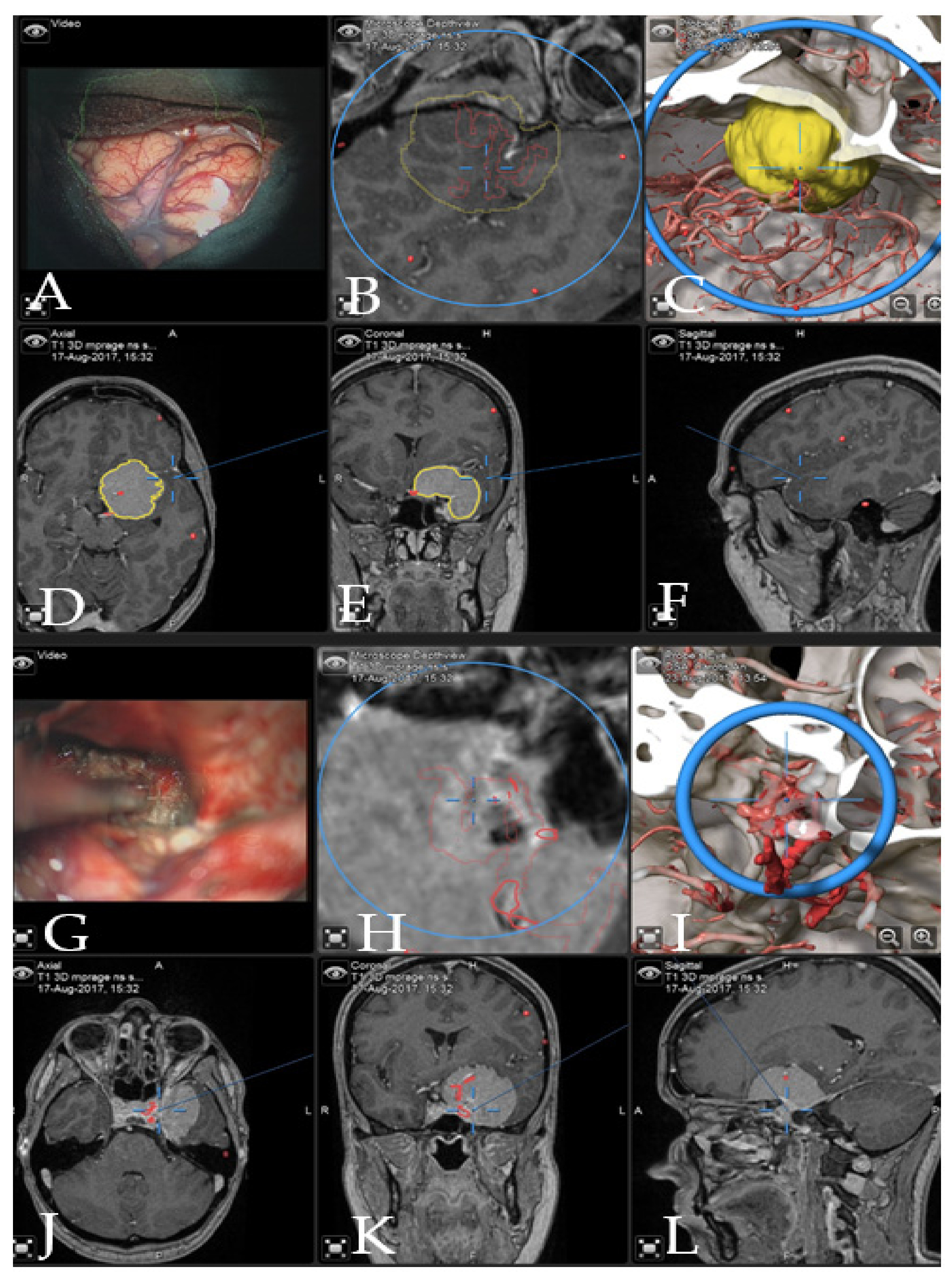

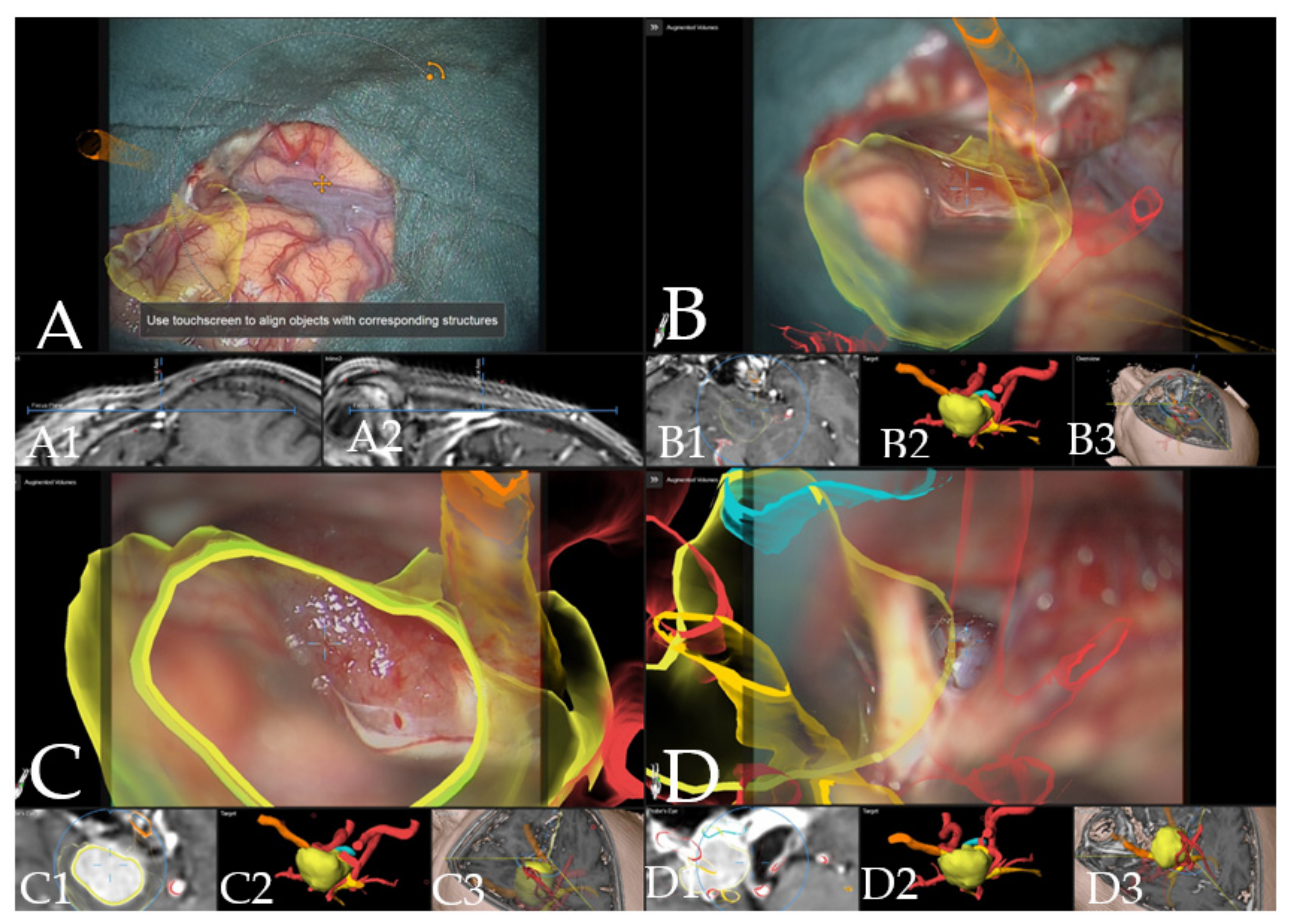
| No. | Sex | Age (Years) | Location of the Tumor | Extent of Resection | Simpson Grade | Tumor Volume (cm3) | Visualized Objects in AR |
|---|---|---|---|---|---|---|---|
| 1 | m | 57 | Cavernous sinus/petroclival right | PR | IV | 11 | Tumor, Vessels |
| 2 | f | 64 | Clinoidal left | GTR | II | 13.4 | Tumor, Vessels, Chiasm, Optic Nerves, Optic Tracts, Ventricles |
| 3 | m | 55 | Cavernous sinus right | Open Biopsy | V | 3.3 | Tumor, Vessels, Chiasm, Optic Nerves, Optic Tracts |
| 4 | m | 67 | Anterior fossa/planum sphenoidale | GTR | II | 53 | Tumor |
| 5 | m | 80 | Olfactory meningioma | GTR | I | 14.3 | Tumor, Chiasm, Optic Nerves, Optic Tracts, Ventricles, Cerebrum |
| 6 | f | 50 | Middle and posterior fossa/petrous left | PR | IV | 68.8 | Tumor |
| 7 | m | 65 | Medial sphenoid wing meningioma left | GTR | II | 15.8 | Tumor, Vessels, Chiasm, Optic Nerves, Optic Tracts |
| 8 | f | 89 | Anterior fossa/planum sphenoidale | STR | IV | 44.2 | Tumor, Vessels, Chiasm, Optic Nerves, Optic Tracts |
| 9 | f | 38 | Medial sphenoid wing left | GTR | II | 39.2 | Tumor, Vessels |
| 10 | m | 81 | Lateral sphenoid wing right | GTR | II | 64.6 | Tumor, Vessels |
| 11 | f | 76 | Olfactory meningioma | GTR | I | 10.7 | Tumor, Chiasm, Optic Nerves, Optic Tracts |
| 12 | f | 76 | Olfactory meningioma | GTR | II | 60.4 | Tumor |
| 13 | m | 48 | Lateral sphenoid wing left | STR | III | 98.2 | Tumor, Vessels, Chiasm, Optic Nerves, Optic Tracts |
| 14 | f | 558 | Cavernous sinus left | PR | V | 62.1 | Tumor, Vessels, Chiasm, Optic Nerves, Optic Tracts |
| 15 | f | 83 | Clinoidal meningioma right | GTR | II | 3.18 | Tumor, Vessels, Chiasm, Optic Nerves, Optic Tracts |
| 16 | f | 80 | Planum sphenoidale | STR | IV | 3.47 | Tumor |
| 17 | m | 46 | Olfactory meningioma | GTR | II | 5.91 | Tumor |
| 18 | f | 51 | Anterior fossa/planum sphenoidale | GTR | II | 53.4 | Tumor, Vessels |
| 19 | f | 67 | Suprasellar meningioma | GTR | I | 8.45 | Tumor, Vessels, Chiasm, Optic Nerves, Optic Tracts, Pituitary Gland |
| 20 | f | 50 | Anterior fossa/falx | GTR | II | 109 | Tumor, Vessels |
| 21 | f | 71 | Suprasellar meningioma | GTR | II | 1.32 | Tumor, Vessels, Chiasm, Optic Nerves |
| 22 | m | 82 | Cavernous sinus right | STR | III | 26.7 | Tumor, Vessels, Chiasm, Optic Nerves, Optic Tracts |
| 23 | f | 82 | Suprasellar meningioma | GTR | II | 6.05 | Tumor, Vessels, Bone, Chiasm, Optic Nerves, Optic Tracts |
| 24 | m | 71 | Recurrent clinoidal meningioma right | STR | III | 0.54 | Tumor, Vessels, Bone, Chiasm, Optic Nerves, Optic Tracts, Ventricles, Cerebrum |
| 25 | f | 60 | Olfactory meningioma | GTR | I | 1.66 | Tumor |
| 26 | f | 68 | Medial sphenoid wing right | GTR | II | 1.28 | Tumor |
| 27 | f | 54 | Lateral sphenoid wing right | GTR | II | 20.6 | Tumor, Vessels, Chiasm, Optic Nerves, Optic Tracts |
| 28 | f | 77 | Clinoidal meningioma right | GTR | I | 8.43 | Tumor, Vessels, Chiasm, Optic Nerves, Optic Tracts |
| 29 | f | 67 | Cavernous sinus meningioma left | PR | V | 11 | Tumor, Vessels |
| 30 | f | 71 | Clinoidal meningioma right | GTR | I | 3.34 | Tumor, Vessels, Chiasm, Optic Nerves, Optic Tracts |
| 31 | m | 55 | Recurrent lateral sphenoid wing left | STR | IV | 24.8 | Tumor, Vessels, Chiasm, Optic Nerves, Optic Tracts |
| 32 | f | 41 | Lateral sphenoid wing right | STR | IV | 29.8 | Tumor, Vessels, Chiasm, Optic Nerves, Optic Tracts |
| 33 | m | 64 | Medial sphenoid wing right | GTR | II | 28.2 | Tumor, Vessels, Chiasm, Optic Nerves, Optic Tracts |
| 34 | f | 70 | Clinoidal meningioma right | GTR | I | 2.92 | Tumor, Chiasm, Optic Nerves, Optic Tracts |
| 35 | f | 47 | Recurrent medial sphenoid wing right | PR | IV | 7.12 | Tumor, Vessels |
| 36 | m | 72 | Olfactory meningioma | GTR | I | 68.9 | Tumor, Vessels |
| 37 | f | 71 | Anterior fossa/planum sphenoidale | GTR | II | 1.4 | Tumor |
| 38 | f | 52 | Cavernous sinus/temporobasal meningioma left | GTR | II | 1.8 | Tumor |
| 39 | f | 45 | Suprasellar meningioma right | GTR | II | 1.91 | Tumor, Vessels, Chiasm, Optic Nerves, Optic Tracts |
| No. | Symptoms | Neurological Deficits Prior to Surgery | Neurological Deficits Following Surgery |
|---|---|---|---|
| 1 | Incidental following mild TBI | None | None |
| 2 | Visual symptoms | Visual deterioration (Visus R 0.3, L 0.7) | Improved vision (Visus R 0.5, L 1.0) |
| 3 | CNVI palsy | CNVI palsy | CNVI palsy |
| 4 | Tremor | Tremor | None |
| 5 | Anosmia, headache | Anosmia | Anosmia |
| 6 | Headache | None | None |
| 7 | Seizure | None | CNIII palsy |
| 8 | Blindness right eye | Blindness right eye | Unchanged |
| 9 | Vertigo | None | None |
| 10 | Double vision | None | None |
| 11 | Headache | Anosmia | Anosmia |
| 12 | Gait difficulties, anosmia | Anosmia | Anosmia |
| 13 | Visual symptoms | Visual deterioration | None |
| 14 | Visual symptoms | CNIII palsy | CN III palsy |
| 15 | Visual symptoms | Visual deterioration (R 0.2, L 0.7) | Improved vision (R 0.2, L 0.8) |
| 16 | Visual symptoms | Visual deterioration (R 0.1, L 0.4) | Improved vision (R 0.2, L 0.3) |
| 17 | Seizure | None | None |
| 18 | Seizure | None | None |
| 19 | Visual symptoms | Visual det (R 0.7, L 0.8), bitemp. hemianopsia | Improved vision (R 0.7, L 0.9) |
| 20 | Hydrocephalus | None | None |
| 21 | Hypesthesia in right upper extremity | None | None |
| 22 | Seizure | None | None |
| 23 | CNIV palsy | CNIV palsy | CN IV palsy |
| 24 | Visual symptoms | Visual deterioration (L 0.16) | Improved vision (L 0.2) |
| 25 | Incidental finding | None | None |
| 26 | Screening due to renal carcinoma | None | None |
| 27 | Depression | None | None |
| 28 | Visual symptoms | Visual field deficits R | None |
| 29 | CN IV palsy | CN IV palsy | CN IV palsy |
| 30 | Depression | None | None |
| 31 | None- MRI follow-up following prior surgery | CN IV palsy, CN III palsy | CN IV and CN III palsy |
| 32 | Visual symptoms | Visual deterioration (R 0.6, L 1) | Improved vision (R 1.0) |
| 33 | Visual symptoms, dementia | Visual deterioration (R 0.2, L 0.05) | Unchanged vision (R 0.2, L 0.05) |
| 34 | Visual symptoms | Visual deterioration (R 0.7) | Unchanged vision (R 0.7) |
| 35 | None- MRI follow-up following prior surgery | None | None |
| 36 | Coma | Anosmia | Anosmia |
| 37 | Headache | None | None |
| 38 | Cognitive problems | None | None |
| 39 | Headache | None | None |
Publisher’s Note: MDPI stays neutral with regard to jurisdictional claims in published maps and institutional affiliations. |
© 2022 by the authors. Licensee MDPI, Basel, Switzerland. This article is an open access article distributed under the terms and conditions of the Creative Commons Attribution (CC BY) license (https://creativecommons.org/licenses/by/4.0/).
Share and Cite
Pojskić, M.; Bopp, M.H.A.; Saβ, B.; Carl, B.; Nimsky, C. Microscope-Based Augmented Reality with Intraoperative Computed Tomography-Based Navigation for Resection of Skull Base Meningiomas in Consecutive Series of 39 Patients. Cancers 2022, 14, 2302. https://doi.org/10.3390/cancers14092302
Pojskić M, Bopp MHA, Saβ B, Carl B, Nimsky C. Microscope-Based Augmented Reality with Intraoperative Computed Tomography-Based Navigation for Resection of Skull Base Meningiomas in Consecutive Series of 39 Patients. Cancers. 2022; 14(9):2302. https://doi.org/10.3390/cancers14092302
Chicago/Turabian StylePojskić, Mirza, Miriam H. A. Bopp, Benjamin Saβ, Barbara Carl, and Christopher Nimsky. 2022. "Microscope-Based Augmented Reality with Intraoperative Computed Tomography-Based Navigation for Resection of Skull Base Meningiomas in Consecutive Series of 39 Patients" Cancers 14, no. 9: 2302. https://doi.org/10.3390/cancers14092302
APA StylePojskić, M., Bopp, M. H. A., Saβ, B., Carl, B., & Nimsky, C. (2022). Microscope-Based Augmented Reality with Intraoperative Computed Tomography-Based Navigation for Resection of Skull Base Meningiomas in Consecutive Series of 39 Patients. Cancers, 14(9), 2302. https://doi.org/10.3390/cancers14092302









